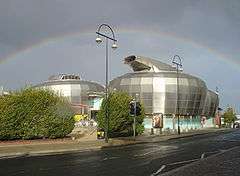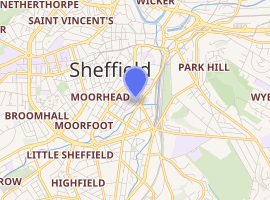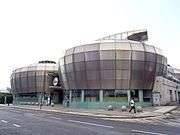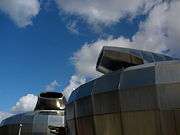National Centre for Popular Music
The National Centre for Popular Music was a museum in Sheffield, England, for contemporary music and culture, a £15 million project largely funded with contributions from the National Lottery, which opened on 1 March 1999, and closed in June 2000.
| Hallam Union Building of Sheffield | |
|---|---|
 The National Centre for Popular Music | |

| |
| Former names | National Centre for Popular Music |
| Alternative names | The HUBs |
| General information | |
| Type | Museum |
| Architectural style | Avant-garde |
| Location | Sheffield, South Yorkshire |
| Address | Paternoster Row |
| Coordinates | 53.3775°N 1.4660°W |
| Current tenants | Sheffield Hallam University Students' Union |
| Completed | February 1999 |
| Inaugurated | 1 March 1999 |
| Cost | £15 million (Lottery funded by £11m) |
| Owner | Sheffield Hallam University |
| Technical details | |
| Structural system | Stainless steel drums |
| Design and construction | |
| Architect | Nigel Coates |
| Architecture firm | Branson Coates |
Building
The building, designed by Branson Coates following an architectural design competition managed by RIBA Competitions, consists of four giant stainless steel drums, surrounding an atrium area, the upper floor of which has a glazed roof.[1]
Each of the drums has a rotating turret with a nozzle which is meant to turn with the wind and vent air. On the other side, an opening facing the wind takes inlet air down through wall cavities, being heated or cooled as required. Air is drawn out of the nozzle by buoyancy and wind pressure.[2]
The ground floor contained office space, a shop, a bar, a café and a further exhibition space. Access to this floor was free, with only the top floor forming the museum.
 The front of the building from Paternoster Row.
The front of the building from Paternoster Row. The roof of the HUBS.
The roof of the HUBS. Detail of one of the tops.
Detail of one of the tops.
Closure
The Centre failed to attract enough visitors and cash flow to ensure its viability for its 79 workers – BBC News described the centre as having been "shunned" by visitors, and, despite a £2 million relaunch, the Centre closed in 2000.
Ticket prices were about £21 for a family of four. It was hoped to attract 400,000 visitors a year. After seven months, there had been 104,000 visitors,[3] and on 18 October 1999 the building's owners, Music Heritage Ltd, called in PricewaterhouseCoopers to administer its day-to-day running. The company was to be liquidated in that November if administration was not successful. It was saved in the interim although £1.1 million was owed to 200 creditors.[4] The estimate of visitors per year was reduced to 150,000. Martin King, the chief executive who took over from Stuart Rogers, resigned in January 2000.
Just prior to closure, BBC Radio 2 held an event hosted by Billy Bragg and attended by around 75 prizewinners, to see Madness perform live with support from Paul Carrack.
Subsequent use
The building became a live music venue for a period from July 2001,[5] then in 2003 Sheffield Hallam University bought it from Yorkshire Forward for £1.85 million.[6] It is now the university's Students' Union.[7]
See also
- List of music museums
- National Science and Media Museum
- Millennium Dome
- British Music Experience – opened ten years later in March 2009 in London
References
- "National Centre for Popular Music". www.architonic.com. Architonic. Retrieved 24 November 2018.
- Anonymous (2002). "Robust design - form follows funk: National Centre for Popular Music, Sheffield". The Architectural Review. 211 (1259 Suppl.): 8–9.
- "Debts rock pop museum". BBC News: Entertainment. 18 October 1999. Retrieved 30 March 2020.
- "Pop museum saved". BBC News: Entertainment. 2 November 1999. Retrieved 30 March 2020.
- "£2m relaunch for national pop centre". BBC News: Entertainment. 19 July 2001. Retrieved 30 March 2020.
- "University buys pop centre". BBC News: England. 20 February 2003. Retrieved 30 March 2020.
- "Ex-pop centre prepares for students". BBC News: England. 5 July 2003. Retrieved 30 March 2020.
External links
- Sheffield Hallam University Students Union
- "Sheffield steels itself for pop centre". BBC News: Entertainment. BBC. 26 February 1999. Retrieved 23 November 2018.